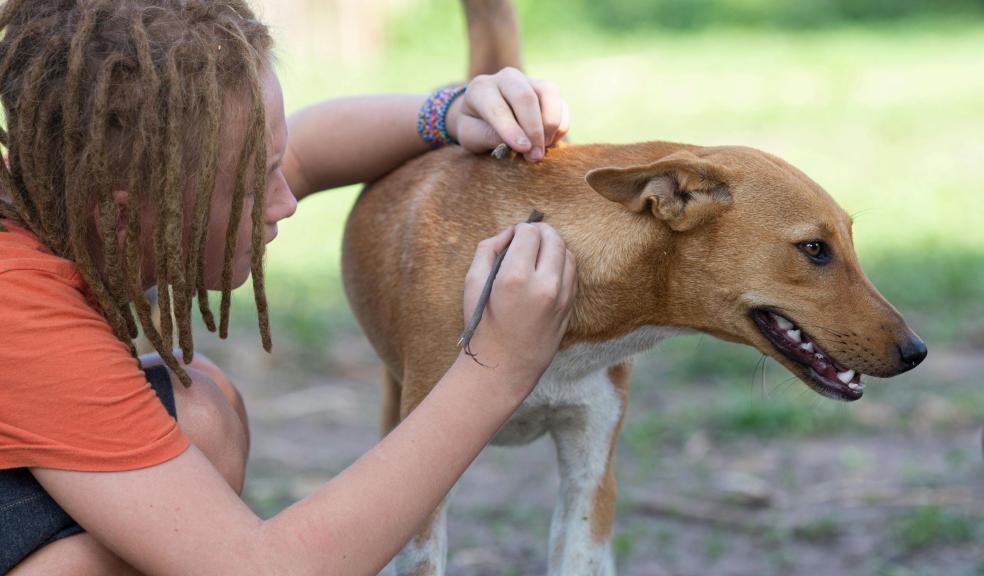
Lyme disease: Vet advises on everything you need to know before you panic
Lyme disease has been the top trending symptom search in the UK (up +110% according to Google Trends) overtaking hayfever searches. Temperatures are rising and as the UK Health Security Agency (UKHSA) has stated, this creates 'favourable conditions' for ticks to thrive - between April and September last year, there were 882 acute cases of Lyme disease in England. But what if you suspect your dog has been infected after a nice walk in the park?
With that in mind, the vets at Admiral Pet Insurance wanted to offer advice to dog owners who are spending more time outdoors since the weather is getting warmer. See below a comprehensive guide that Admiral's in-house veterinary nurse, Nicki Fox, has put together on what you should know and look out for if you suspect your dog has any of the symptoms of this disease.
1. What is Lyme Disease and can dogs get it?
Yes, but don't panic! Lyme disease comes from a bacteria found in ticks which is called Borrelia, also known as 'Borreliosis'. When the tick attaches, its saliva enters the bloodstream, leading to the bacteria to travel to various tissues and organs. The infected tick can stay attached for several hours to feed. Just as humans, dogs are receptible to the disease by being bitten by an infected tick, although most dogs that that are exposed to Lyme disease will not become unwell (only approximately 1.5% of ticks carry this bacteria in the UK). However, it is important to keep an eye out for symptoms as if left untreated, Lyme Disease can result in chronic illness.
2. What are the signs of Lyme Disease in dogs?
Whilst Lyme Disease can manifest itself differently from dog to dog, some might not show any signs at all. It's also important to note that symptoms typically only appear between 2–5 months after the bite. Some common signs to look out for in your dog are:
-
Lameness: This comes from inflammation of the joints, which is also one of the most recognised signs that your dog has Lyme Disease. Lameness can come and go, but also shift from one leg to another. Keep extra attention to your dog if you notice this. This usually starts in the joints closet to the tick bite.
-
Fever (high temperature): Your dog can also develop a fever, which can lead to loss of appetite.
-
Joint pain: If you see stiffness or signs of joint pain, especially during movement, this can be a sign of Lyme Disease.
-
Swollen lymph nodes: Your dog's lymph nodes might be enlarged, especially around the affected joints.
-
Depression: If your dog is infected, you might notice signs of depression or changes in their behaviour.
-
Lethargy: Your dog might get exhausted and sluggish from the illness, which you'll notice in a reduced level of activity.
-
Reduced appetite: Your dog's appetite will be noticeably reduced when they're unwell, so keep an eye out for this.
-
Increased drinking and urination: If you notice your dog drinking or urinating more than usual, this could be a sign of illness.
3. How to prevent ticks in dogs and what to do if you discover ticks on your dog
Peak tick reason is usually during spring and summer, so being more observant during those months is crucial. Ticks are common in wooded areas, forests and grasslands, so during those seasons it can be a good idea to stick to cleared paths when going on walks. If you have a garden, make sure it's well-maintained by keeping grass short and removing leaf litter.
Longer haired dogs are more susceptible to getting ticks and their coats make ticks harder to see. I would suggest brushing your dog's coat thoroughly after a walk to check for potential parasite passengers!
Preventing tick bites in dogs is extremely important, as it will reduce the risk of Lyme Disease and other illnesses. Some measures you can take to prevent ticks is to use veterinarian-recommended and prescribed tick control products, usually topical, collars or oral tick products. These can repel and kill ticks on your dogs if you use them correctly.
To spot ticks quickly, it's important to do regular tick checks on your dog, especially after having spent time outdoors. Areas to check more thoroughly include ears, between toes, under the legs and around their neck.
You can purchase a tick remover from your vet or online. Do not be tempted to remove the tick with tweezers or your fingers as the head is likely to be left in the dog's skin when the body is pulled away, or you could end up pushing the blood back into the dog's body. I keep an O Tom Tick Twister in my dog walking bag which contains clear instructions to remove the tick in its entirety.
If you're struggling to get the ticks off or if you're afraid to do so, you can contact your veterinarian for assistance. There are many treatments that can rid your dog of ticks within 48 hours and thus prevent a Lyme Disease infection to develop. A combination of flea/worm/tick products can be cost-effective and easier to use. Consult your vet, who is the best person to provide a proper diagnosis and course of action. Exceptionally, more severe cases may require extensive testing and treatment.
4. What to do if you suspect your dog might have Lyme Disease.
If you suspect your dog might have Lyme Disease, you should consult with your vet as soon as possible to reach a proper diagnosis. They can run tests to determine if your dog has Lyme Disease or any other illness and provide the right treatment.
Expert quote:
"Ticks are a very common insect in the UK and they can easily bite you and your dog when walking in woodlands, forests and leafy areas. Although bites can lead to Lyme Disease and other complications, ticks are generally harmless if removed swiftly and bites monitored, so do regular tick-checks of your dogs after every walk and keep an eye out for your dog's wellness signs."







